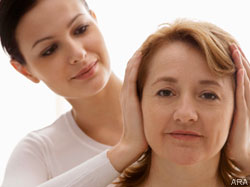(ARA) – The benefits of touch have long been associated with relaxation and a sense of well being. Increasing numbers of people are seeking massage as a way to relax. Forty percent of women and 29 percent of men reported having a massage in the past five years, according to a 2010 Massage Therapy Industry Fact Sheet compiled by the American Massage Therapy Association (AMTA), in July of 2009.
Health care providers and hospitals, too, are embracing massage therapy with growing appreciation for its effectiveness in helping patients. The AMTA’s 2010 Industry Fact Sheet shows that 76 percent of massage therapists received referrals from health care professionals, up from 69 percent in 2008. Why? An increasing number of studies indicate that massage therapy produces beneficial results in relieving pain, lowering blood pressure, and improving circulation, among other benefits.
“Massage therapy has moved mainstream, but it’s rooted in medicine,” says Susan Zolvinski, allied health chairperson at Brown Mackie College – Michigan City. “I learned the basics of massage therapy in nursing school 30 years ago. A simple back rub can reduce the heart rate, lower blood pressure and de-stress a patient. It’s a good complement to the wonderful treatments we have.” Today, the field has expanded dramatically, with many different sub-specialties within the more than 300 different types of massage.
“At first, it was general physicians giving referrals, then chiropractors and physical therapists recognized the benefits. Now massage therapy is integrated into many different treatment plans,” says Melissa DeFrancesco, program director for health and therapeutic massage therapy at Brown Mackie College – South Bend. Nearly every age group is represented in the use of massage therapy. It is used in treating the elderly, athletes and people with specific diseases like cancer or muscular dystrophy, infants, and individuals who suffer from chronic pain.
Even with the buzz generated by this up-and-coming profession, many people don’t realize just what massage therapy entails. “We work with muscles, tendons, ligaments that attach to muscles, and fascia or connective tissue and the lymphatic system, which serves as the body’s sewage and waste disposal system,” says DeFrancesco,
“A lot of science goes into it,” says Zolvinski. “The beauty of it is combining art with science. We take knowledge of how the body works and functions, and apply the different massage therapy modalities to create a specific plan to help each individual. Every massage is different.”
For instance, massage therapy is commonly used in treating breast cancer. “When the lymph system is compromised due to mastectomy, stimulation is important to help fend off lymph edema, which is painful swelling. We apply gentle, constant pressure to help redirect fluid past an area where lymph nodes have been removed. Creating a ‘detour’ helps to move fluid along, thereby reducing swelling,” continues Zolvinski.
The rise of massage therapy diploma programs is designed to meet the growing demand for professionals. A comprehensive program prepares students with knowledge of anatomy, physiology, finger-pressure techniques and the use of complementary aids such as heat and ice. Course components also help students develop practical skills to assess joint quality and muscle strength, create individualized treatment plans, maintain client relationships and manage the business aspects of the profession.
Massage therapy appeals to many people because of the flexibility it allows. Often pursued as a second career, a qualified massage therapist can seek work at salons and spas, fitness centers, medical facilities, hotels, airports and cruise ships, to name a few. The majority are self-employed, working independently.
“Credentialing is required in 43 states and the District of Columbia,” says DeFrancesco. “Most states that currently don’t test for certification have passed laws to do so, but not yet implemented them.”

